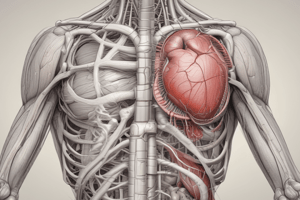Podcast
Questions and Answers
How do cardiac muscles differ from skeletal muscle cells?
How do cardiac muscles differ from skeletal muscle cells?
- Cardiac muscle is voluntary and found in the limbs.
- Cardiac muscle is striated but connected at irregular angles. (correct)
- Skeletal muscle has intercalated discs.
- Skeletal muscle is primarily involuntary.
What are intercalated discs?
What are intercalated discs?
Microscopic identifying features of cardiac muscle that support synchronized contraction.
Why do cardiac muscle fibers have gap junctions?
Why do cardiac muscle fibers have gap junctions?
They allow direct transmission of the depolarizing current from cell to cell.
Why is cardiac muscle highly oxidative?
Why is cardiac muscle highly oxidative?
Explain why cardiac muscle has a relatively long action potential.
Explain why cardiac muscle has a relatively long action potential.
Why doesn't cardiac muscle have wave summation?
Why doesn't cardiac muscle have wave summation?
What is meant by Ca2+-induced Ca2+ release in cardiac muscle?
What is meant by Ca2+-induced Ca2+ release in cardiac muscle?
How does smooth muscle differ from skeletal muscle?
How does smooth muscle differ from skeletal muscle?
Where is smooth muscle found?
Where is smooth muscle found?
What are dense bodies in smooth muscle?
What are dense bodies in smooth muscle?
Why does Ca2+ for the contraction of smooth muscle come from extracellular fluid?
Why does Ca2+ for the contraction of smooth muscle come from extracellular fluid?
How is most smooth muscle innervated?
How is most smooth muscle innervated?
What is single-unit (or visceral) smooth muscle?
What is single-unit (or visceral) smooth muscle?
What is multi-unit smooth muscle?
What is multi-unit smooth muscle?
Briefly list local factors that regulate smooth muscle contraction.
Briefly list local factors that regulate smooth muscle contraction.
What is excitation-contraction coupling in smooth muscle?
What is excitation-contraction coupling in smooth muscle?
What role does caldesmon play in smooth muscle contraction?
What role does caldesmon play in smooth muscle contraction?
What is myosin light-chain kinase?
What is myosin light-chain kinase?
Where is skeletal muscle found?
Where is skeletal muscle found?
Study Notes
Cardiac Muscle
- Involuntary muscle located solely in the heart, distinguishing it from skeletal muscle.
- Striated appearance due to regular arrangements of fibers and sarcomeres.
- Features intercalated discs for structural integrity and synchronized contraction.
Intercalated Discs
- Microscopic structures unique to cardiac muscle.
- Essential for supporting the simultaneous contraction of cardiac tissue.
Gap Junctions in Cardiac Muscle
- Composed of protein-lined tunnels facilitating direct electrical signaling.
- Allow rapid transmission of depolarization across heart cells for coordinated contraction.
Oxidative Nature of Cardiac Muscle
- Relies heavily on aerobic respiration for ATP production, primarily through β-oxidation of fatty acids.
- Sensitive to oxygen supply; function declines if coronary blood flow is insufficient.
Action Potential Duration in Cardiac Muscle
- Characterized by a prolonged plateau phase during depolarization.
- Longer action potential translates to extended contraction duration.
Lack of Wave Summation in Cardiac Muscle
- Long refractory period prevents wave summation and tetanus.
- Ensures rhythmic, effective heart contractions without fatigue.
Calcium-Induced Calcium Release
- Initial sarcolemma depolarization opens voltage-gated Ca2+ channels.
- Leads to a cascade of calcium influx, crucial for muscle contraction.
Smooth Muscle Characteristics
- Non-striated, involuntary muscle not under conscious control.
- Found in walls of hollow organs, enabling various physiological functions.
Locations of Smooth Muscle
- Present in structures such as intestines, stomach, and blood vessels.
Dense Bodies in Smooth Muscle
- Structures where actin filaments of contractile units attach.
- Play a role in maintaining structural organization during contraction.
Calcium Source for Smooth Muscle Contraction
- Calcium required for contraction originates from extracellular fluid.
- Diffuses into the cytoplasm, initiating and sustaining contraction.
Innervation of Smooth Muscle
- Primarily innervated by sympathetic nervous system via adrenergic receptors.
- Utilizes neurotransmitters like norepinephrine (NE) and acetylcholine (ACh).
Single-Unit Smooth Muscle
- Known as visceral smooth muscle, located in areas like the uterus and gastrointestinal tract.
- Exhibits fatigue resistance, rapid contraction onset, and cannot undergo tetanus.
Multi-Unit Smooth Muscle
- Composed of cells with rare gap junctions, preventing electrical coupling.
- Located in airways leading to the lungs and in large blood vessels.
Regulation of Smooth Muscle Contraction
- Membrane potential influences contraction initiation and modulation.
- Local factors include hormones, humoral factors, and mechanical stimuli such as cell stretching.
Excitation-Contraction Coupling in Smooth Muscle
- Calmodulin binds to calcium ions, initiating the activation of myosin light-chain kinase.
- Caldesmon, a calcium-binding protein, inhibits myosin's ATPase activity, regulating contraction.
- Myosin light-chain kinase enhances interaction between myosin and actin, promoting contractility.
Skeletal Muscle Characteristics
- Found between bones, connected to bone via tendons and epimysium.
- Distinctly striated, comprised of parallel bundles, and under voluntary control.
Studying That Suits You
Use AI to generate personalized quizzes and flashcards to suit your learning preferences.
Description
This quiz compares cardiac and skeletal muscle cells, focusing on their structural differences and unique features such as intercalated discs. Test your understanding of muscle types with this study guide. Perfect for students studying anatomy and physiology.




